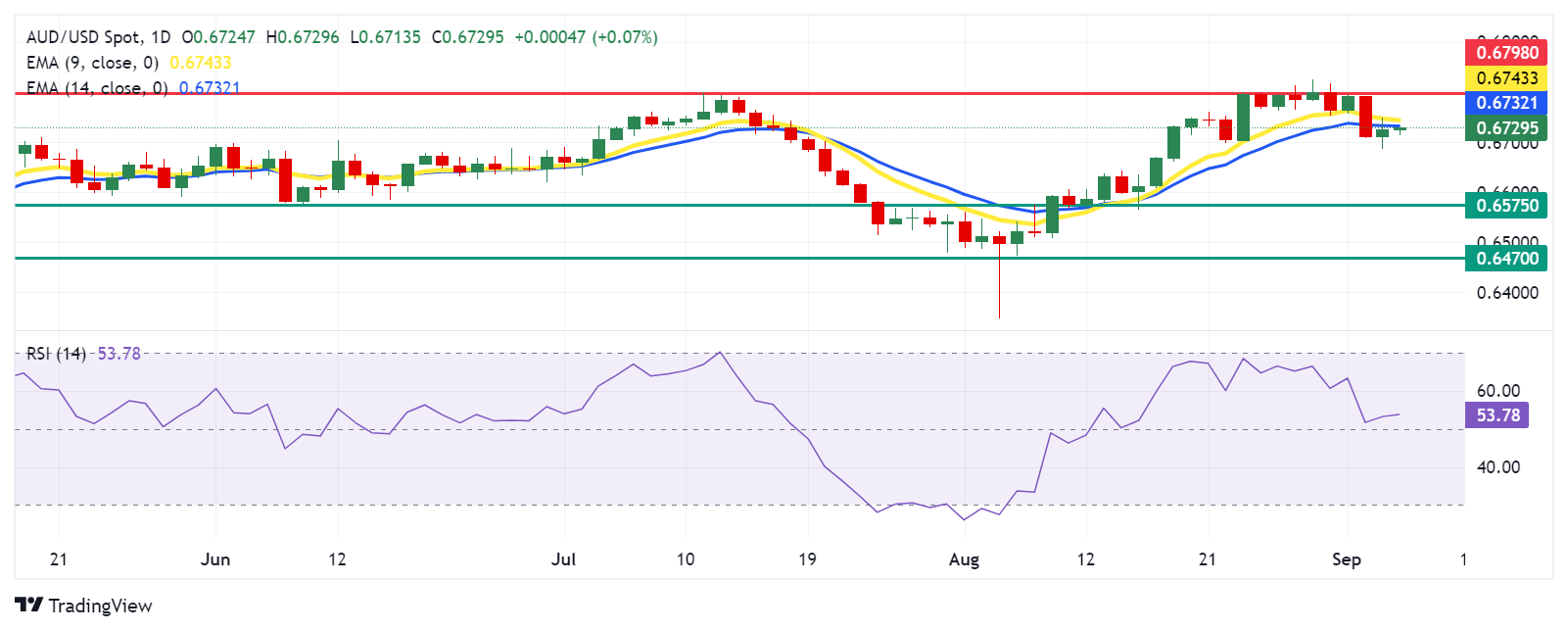- The Australian dollar continues to face downward pressure following the release of trade balance data on Thursday.
- Australia’s trade balance posted a surplus of $6.009 billion month-on-month in July, compared with the $5.150 billion expected.
- The US Dollar came under downward pressure following recent disappointing economic data.
The Australian Dollar (AUD) is higher against the US Dollar (USD) following the release of trade balance data on Thursday. Australia’s trade surplus widened to $6.009 billion month-on-month in July, beating the $5.150 billion expected and the $5.589 billion in the previous reading. Traders are awaiting a speech by Reserve Bank of Australia (RBA) Governor Michele Bullock later in the day.
The Australian dollar came under downward pressure as recent figures showed Australia’s gross domestic product (GDP) grew in the second quarter but missed market expectations. A private survey also showed the country’s manufacturing activity remained in contraction in August, extending the sector’s two-year decline.
The US dollar weakened after US JOLTS job openings in July came in below expectations, signaling a further slowdown in the labor market. In addition, the ISM manufacturing PMI showed that factory activity contracted for the fifth consecutive month.
Traders now await ISM services PMI data and US initial jobless claims scheduled for release on Thursday. Attention will shift to Friday’s US non-farm payrolls (NFP) for further clues on the potential size of an expected Fed rate cut this month.
Daily Market Movers Roundup: Australian Dollar Appreciates as Trade Surplus Widens
- Atlanta Federal Reserve President Raphael Bostic said on Wednesday that the Fed is in a favorable position but added that they should not maintain a restrictive policy for too long, according to Reuters. FXStreet’s FedTracker, which measures the tone of Fed officials’ speeches on a dovish-to-hawkish scale from 0 to 10 using a custom AI model, rated Bostic’s words as neutral with a score of 4.6.
- U.S. JOLTS job openings fell to 7.673 million in July from 7.910 million in June, marking the lowest level since January 2021 and falling short of market expectations of 8.10 million.
- Bank of America (BoA) has revised its economic growth forecast for China, lowering its 2024 projection to 4.8% from 5.0% previously. For 2025, the forecast is adjusted to 4.5% growth, while the outlook for 2026 remains unchanged at 4.5%.
- China’s services Purchasing Managers’ Index (PMI) fell from 52.1 in July to 51.6 in August, which is remarkable considering the close trading relationship between China and Australia.
- Australia’s Gross Domestic Product (GDP) posted a quarterly reading of 0.2% for the second quarter, down from 0.1% in the previous quarter but below the expected reading of 0.3%.
- The Judo Bank Composite PMI rose to 51.7 in August from 51.4 in July, marking the fastest expansion in three months. This growth was mainly driven by an increase in services activity, with the services PMI reaching 52.5 in August from 52.2 in July, marking the seventh consecutive month of growth in the services sector.
- The US ISM manufacturing PMI rose to 47.2 in August from 46.8 in July, falling short of market expectations of 47.5. This marks the 21st contraction in US factory activity in the past 22 months.
Technical Analysis: Australian Dollar Holds Above 0.6700
The Australian dollar is trading around 0.6720 on Thursday. Looking at the daily chart, the AUD/USD pair is positioned below the nine-day exponential moving average (EMA), which suggests a bearish trend in the short term. However, the 14-day relative strength index (RSI) has moved above the 50 level, which suggests that the asset price is leaning towards the bullish side.
On the downside, the AUD/USD pair could test the retracement level near 0.6575, with a deeper drop targeting the lower support around 0.6470.
In terms of resistance, the AUD/USD pair could find the immediate barrier at the 14-day EMA around 0.6731, followed by the nine-day EMA at 0.6742. A break above these levels could pave the way for a test of the seven-month high at 0.6798.
AUD/USD: Daily Chart
Australian Dollar PRICE Today
The table below shows the Australian Dollar (AUD) exchange rate against major currencies today. Australian Dollar was the strongest currency against the Swiss Franc.
| USD | EUR | GBP | JPY | CAD | AUD | NZD | CHF | |
|---|---|---|---|---|---|---|---|---|
| USD | 0.00% | -0.07% | -0.01% | -0.01% | -0.09% | -0.01% | 0.04% | |
| EUR | 0.00% | -0.05% | -0.02% | 0.00% | -0.08% | 0.04% | 0.04% | |
| GBP | 0.07% | 0.05% | 0.04% | 0.08% | -0.02% | 0.09% | 0.09% | |
| JPY | 0.01% | 0.02% | -0.04% | 0.00% | -0.09% | -0.00% | 0.05% | |
| CAD | 0.01% | -0.01% | -0.08% | -0.01% | -0.07% | 0.02% | 0.04% | |
| AUD | 0.09% | 0.08% | 0.02% | 0.09% | 0.07% | 0.10% | 0.12% | |
| NZD | 0.00% | -0.04% | -0.09% | 0.00% | -0.02% | -0.10% | 0.02% | |
| CHF | -0.04% | -0.04% | -0.09% | -0.05% | -0.04% | -0.12% | -0.02% |
The heatmap shows percentage changes of major currencies. The base currency is selected from the left column, while the quote currency is selected from the top row. For example, if you choose the Australian Dollar from the left column and move along the horizontal line to the US Dollar, the percentage change shown in the chart will represent the AUD (base)/USD (quote).
Australian Dollar FAQs
One of the most important factors for the Australian Dollar (AUD) is the level of interest rates set by the Reserve Bank of Australia (RBA). Since Australia is a resource-rich country, another key factor is the price of its largest export, iron ore. The health of the Chinese economy, its largest trading partner, is a factor, as is inflation in Australia, its growth rate and the Trade Balance. Market sentiment, i.e. whether investors are betting on riskier assets (risk-on) or seeking safe havens (risk-off), is also a factor, with risk-on being positive for the AUD.
The Reserve Bank of Australia (RBA) influences the Australian Dollar (AUD) by setting the level of interest rates that Australian banks can lend to each other. This influences the level of interest rates in the economy as a whole. The RBA’s main objective is to maintain a stable inflation rate of 2%-3% by adjusting interest rates up or down. Relatively high interest rates compared to other major central banks support the AUD, and the opposite for relatively low ones. The RBA can also use quantitative easing and tightening to influence credit conditions, with the former being negative for the AUD and the latter positive for the AUD.
China is Australia’s largest trading partner, so the health of the Chinese economy greatly influences the value of the Australian Dollar (AUD). When the Chinese economy is doing well, it buys more raw materials, goods and services from Australia, which increases demand for the AUD and drives up its value. The opposite occurs when the Chinese economy is not growing as fast as expected. Therefore, positive or negative surprises in Chinese growth data often have a direct impact on the Australian Dollar.
Iron ore is Australia’s largest export, worth $118 billion per year as of 2021 data, with China being its main destination. The price of iron ore can therefore be a driver of the Australian dollar. Typically, if the price of iron ore rises, the AUD rises as well, as aggregate demand for the currency increases. The opposite occurs when the price of iron ore falls. Higher iron ore prices also tend to lead to a higher probability of a positive trade balance for Australia, which is also positive for the AUD.
The trade balance, which is the difference between what a country earns from its exports and what it pays for its imports, is another factor that can influence the value of the Australian dollar. If Australia produces highly sought-after exports, its currency will gain value solely because of the excess demand created by foreign buyers wanting to purchase its exports versus what it spends on buying imports. Therefore, a positive net trade balance strengthens the AUD, with the opposite effect if the trade balance is negative.
Source: Fx Street
I am Joshua Winder, a senior-level journalist and editor at World Stock Market. I specialize in covering news related to the stock market and economic trends. With more than 8 years of experience in this field, I have become an expert in financial reporting.








